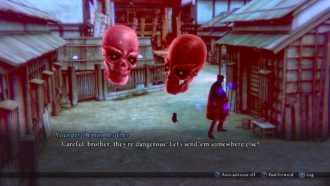Platforms:
PS4, PC, Nintendo Switch, PS5, Xbox Series X|S, Nintendo Switch 2
Released:
June 19, 2025
Publisher:
Sega
Developer:
Atlus
With so many developers pushing barely-changed ports on us and calling them remasters — or worse, remasters that actually ruin the game —we need more to follow ATLUS’ example with RAIDOU Remastered: The Mystery of the Soulless Army. It’s an unwieldy title, but no less so than the original game that is its namesake, Devil Summoner: Raidou Kuzunoha vs. the Soulless Army, which released on PS2 in 2006 as a spin-off to the much more well-known series Shin Megami Tensei. It’s been largely forgotten by the world, but the high-profile releases of Persona 5, Shin Megami Tensei V, and Persona 3 Reload have all helped to boost the franchise into massive mainstream popularity. What a perfect time to revitalise Raidou!
Like so many new Persona fans, I’ve never played the original Raidou and therefore carry no nostalgic torch for it: I’m coming into this as a completely fresh experience. If you had told me that this was a brand new game, while I wouldn’t quite have believed you, all of the work that’s gone into modernising it would really help your case. Apart from a few tell-tale signs that it’s built off the bones of a 20-year-old game, it’s basically as good as any new Shin Megami Tensei. All main characters have been given a graphical facelift, not quite as pretty as Persona 3 Reload, but not that far behind. The iconic, thickly-lined eyes at least give this game a distinct look that separates it from the rest. Major NPCs have been touched up, too, as have the now 120+ ally demons Raidou can recruit. It’s really only the background folk that wander the streets of Tokyo that still scream PS2, which definitely doesn’t ruin the experience, but does look a little jarring.

The story is compelling enough to take you through to the combat, though of course it doesn’t have deep character development like a Persona game would. Raidou Kuzunouha the 14th works as a detective in the Narumi agency in Taisho 20, a period of Japanese history defined by technological advancements and a transitioning culture. But secretly, he’s a devil summoner (this game uses the word demon and devil interchangeably, which is somewhat odd) and part of a secret order designed to keep the world safe from supernatural threats. The story is episodic, split up into separate chapters where Raidou is lead by the nose by his cat companion to investigate mysteries around town, all culminating in a larger mystery that manages to impress me more than Shin Megami Tensei V‘s story ever did. It helps that the full voice acting is really well performed, injecting a lot of energy into the dialogue that wouldn’t have been in the original.
The combat has been given a major overhaul to bring it into this decade, making it play as smooth as a brand new title, even if this type of arena-battle gameplay distinguishes it as a game from the 2000s. Having never played the original, I pulled up an old gameplay video to compare the battle system from old to new, and it’s like night and day. The old Raidou moves so much smoother than the old one, which seems quite stiff to control with a repetitive moveset. The moveset in Raidou Remastered is still a bit repetitive, but it’s broken up by elemental abilities that Raidou himself can now use in battle.
“There are so many features new to the battle system that I can’t imagine enjoying the original without.”
You can now summon two demons to fight alongside you, not just one, which marks another enormous improvement. It’s easier to strategise battles using your demon’s abilities when you’re not limited to just the one in battle — swapping one out with another would be a pain in the ass if you only needed a demon who can cast Dia — now you can have one of your two demon allies to focus on healing and buffing the party, while you and the second demon whale on the enemy. Shooting your gun now swiftly switches you to a first-person view, though it’s not clear to me if this makes for a better shooting function. It certainly looks far nicer and adds a new dimension to the otherwise static arena.
There are so many features new to the battle system that I can’t imagine enjoying the original without: a lock-on function, the new ‘summoner skills’ for Raidou, an option to try the battle again if you die, the list just goes on and on. It seems this new battle system was based on that of the sequel that came out in 2008, so if you played that one, you’ll know what to expect. It’s an extremely impressive overhaul of the combat system.
It’s not just the combat that has been given a generous improvement. Numerous quality of life features allow Raidou Remastered to skip so many of the frustrations that can bring down older games. There are literally dozens of little changes that have been made, so I’ll run through some of the bigger game-changers:
Quicksave, and autosaving, is an obvious force for good. If there’s anything that can be left safely in the past, it’s losing two hours of progress because you died unexpectedly. I wish there were an option to lower the difficulty level on the game over screen too, but the lack of one isn’t a deal breaker. The game is already naturally made easier by another modernisation: all your demons gain EXP from battle, even if you don’t summon them, so there’s virtually no chance you’ll end up underlevelled and needing to waste a bunch of time grinding levels — at least on easy and normal difficulty. Harder difficulties are available, and I’d recommend them to any returning Raidou veterans lest the experience feel too easy. It also means that virtually every battle ends with a level-up screen for any demon who’s levelled up, which quickly gets a bit tedious. A notification at the corner of the screen would have been perfectly fine to convey the same information, especially once a demon has learned all its possible skills.

Express Streetcar is a quick-travelling option selectable from the menu, and is another example of an addition I don’t think I could have lived without. The world of Raidou Remastered is a bit of a maze of 3D maps as well as a larger 2D map of the various streetcar networks, and the thought of having to traverse them every time is frankly awful. The express streetcar menu is an excellent solution, as it will usually display an icon next to the destination that contains your next objective. Weirdly, some objectives don’t show up like this, which makes it slightly unreliable. I think this happens when the objective is not strictly in the area but is a streetcar stop itself, but unfortunately that’s just my best guess. Checking your objectives menu (another good addition for the remaster) will usually solve this, but it’s more of a fiddle than if the objective marker worked 100% of the time like it should.
Here’s a gripe I’ve always had about Persona and SMT games — I dislike the inscrutable logic behind fusing demons. I didn’t even know there was any logic behind it until I recently thought to search it online, so random do the results seem. It leaves me unable to plan ahead for what element of demon I might want or need, which, for any kind of strategy game, seems incongruent. Raidou Remastered saves my life by adding the ‘reverse demon search’ option introduced by Shin Megami Tensei III: Nocturne, which allows you to view fusions by their possible results. The old-fashioned method of selecting each demon one by one to check any fusion options just ain’t it.
Playing on PC is a bit overkill – this game doesn’t need a particularly powerful graphics card or CPU. Initial reports from those with Steam Decks or other handheld devices like the Rog Ally seem to indicate that it runs pretty well on handheld. There’s something about it that screams like I should be playing it on handheld. Maybe I’m just getting nostalgic for playing Persona 4 Golden in the PS Vita.
8.5
Great
Positive:
- A real stand-out example of how to improve an older game for modern gamers
- Completely remade combat makes it feel new
- Compelling story is brought to life with full voice acting
- 50+ more iconic demons from the SMT universe to fuse
Negative:
- Background NPC models still look unimproved
- Some of the improvements introduce new inconveniences
RAIDOU Remastered: The Mystery of the Soulless Army sets a new standard for remasters by offering more improvements and upgrades than many games that bill themselves as full remakes. As someone who never played the original, it feels like I’m playing a modern Shin Megami Tensei title, even though it still has many of the tell-tale signs of a 2000s game. I don’t know how the game could have been playable without such a smooth combat system and the countless quality of life features.











